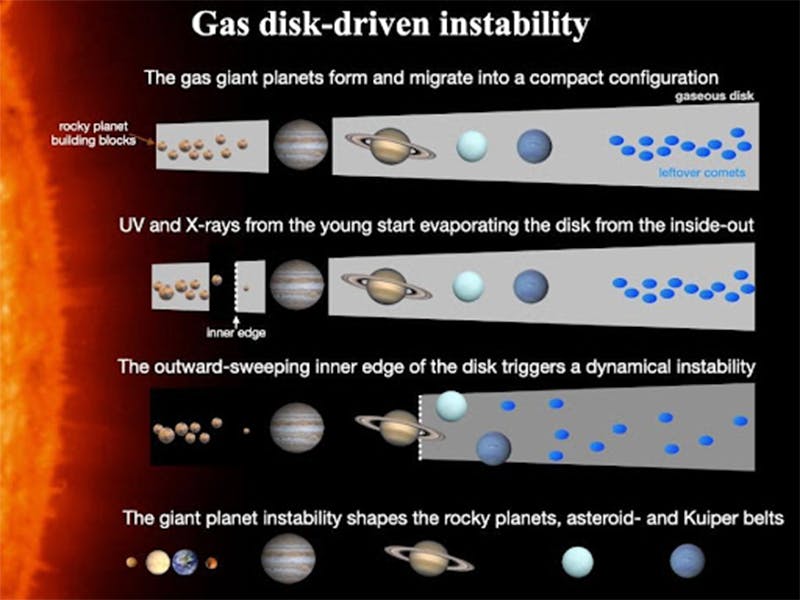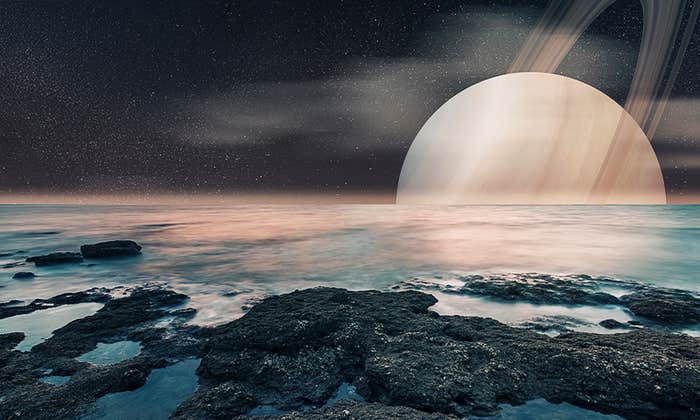Who doesn’t want the trains to run on time? When stuff runs like clockwork, we’re happy. And thankfully, that’s how the planets orbit the sun: dependable, and always on time. But it wasn’t always like this. Scientists suspect the solar system, some time in its early years, underwent a violent seismic shift. The orbits of the gas giants—Jupiter and Saturn—got tweaked big time, and the aftershocks affected all the planets, including Earth and Mars, as well as the asteroid and Kuiper belts.
In our new study, published in Nature, we rewrite the origins of this massive shift—called a “dynamical instability”—and explain how everything in the solar system today found its place. What’s more, our idea is broadly applicable and may explain the orbits of exoplanets.
Did our solar system get lucky?
The idea of a dynamical instability crept into the minds of planetary scientists from the outside, from research on exoplanets. The first exoplanets astronomers discovered around stars like the sun were gas giants on orbits very close to their stars. Call them “hot Jupiters.” They’re exotic, circling about 1 percent of sun-like stars. But once astronomers discovered gas giants on more distant orbits—starting just wider than Mercury’s orbit around the sun—they noticed that the planets’ orbits were often extremely stretched-out.
It’s not immediately obvious, but the stretched out orbit of a gas-giant exoplanet is a massive scar. It’s a remnant of a violent past. When planets’ orbits cross, it leads to close encounters that, due to gravity, deflect the planets’ paths. After a series of encounters, one or more planets get ejected into interstellar space. The survivors have eccentric orbits—a telltale sign of something going seriously out of whack. At least three quarters (and probably 90 to 95 percent) of all giant exoplanet systems must be the survivors of dynamical instabilities.
Which raises the question: Did our solar system get lucky? Our planets have near-circular orbits—did we somehow avoid instability? Several signs point to no. The most compelling is that the giant planets’ orbits appear to have been re-shuffled since they grew out of the sun’s gaseous, planet-forming disk. Simulations show that the giant planets’ orbits should have been near-circular and much more compact. Jupiter’s orbit would be about the same as today, but the orbits of the other giant planets would be shrunk-down, putting Saturn much closer to Jupiter, Uranus close to Saturn’s present-day orbit, and Neptune just a bit farther from the sun. Clearly, the orbits of the giants shifted a lot between their birth and today.
In 2005, researchers took the world of planetary science by storm after coming up with a theory, the Nice model, linking the instability with an apparent spike in the cratering rate on the moon called the “late heavy bombardment.” An analysis of the rocks Apollo astronauts brought back from the moon suggested there was a delayed burst of impacts on the rocky planets about 500 million years after they formed, around 4.1 to 3.8 billion years ago. By that time, the oceans were already around, potentially harboring life. The Nice model, (pronounced like “niece”) after the city in France where it was developed, has survived 17 years of intense scrutiny, and accounts for the orbits of the asteroid belt, Kuiper belt, Jupiter’s Trojan asteroids, and even the irregular moons of the giant planets.
The orbit of a gas-giant exoplanet is a remnant of a violent past.
But a re-analysis of the moon’s craters suggests that there was no cataclysm or spike. The impact rate declined smoothly instead. So, our only hint is that the seismic shift in the early solar system must have happened within the first 100 million years—although this doesn’t tell us whether it happened before Earth and the other rocky planets finished forming or afterward. What triggered the big shift? We show, in our new paper, that it was likely the dispersal of the sun’s planet-forming disk.
Stars that have just formed have disks of gas and dust orbiting them. Yet by 5 to 10 million years of age, almost all of those disks are gone. Where do they go? For the first few million years, the gas in the disks slowly drains onto the star (while some of the dust grows into rocky and ice-rich planets). Once the disk’s density drops low enough, energetic photons from the star carve out an inner hole in the gas disk. Imagine a donut hole growing until the donut itself gets thinner and thinner and just … disappears (gasp!).

The sun’s disappearing donut is what shook the orbits of the already-formed planets. As the outward-sweeping inner edge of the gaseous disk passes by each planet in turn, it drags the planet outward with it. (Jupiter is an exception, as its large mass clears out a gap in the disk near its orbit, blocking the “push” from the sweeping inner edge.) In our simulations, we saw that as Saturn is pushed outward, it approaches the orbits of ice giants Uranus and Neptune. The net effect is to squeeze the planets’ orbits closer together. The stability of planets’ orbits depends on the spacing: More widely-separated orbits are far more stable. The squeezing of the system eventually triggers dynamical instability by causing one ice giant’s orbit to cross that of another, or of Saturn’s.
The gravitational effects of the instability would have stunted Mars’ growth, potentially explaining why it’s so much less massive than Earth. What’s more, the instability would have led asteroids and comets to bombard the growing Earth, rather than one potentially already hosting primitive life. All of this means that planetary systems are bitten by the hand that feeds them, as instabilities among planets are triggered by the disks that spawned them.
The instability was a big deal for our solar system but, compared to those in other exoplanet systems, it was far weaker. Fortunately, Jupiter and Saturn must have avoided any close encounters, because if they had scattered off of each other, Jupiter’s present-day eccentricity would be 5 to 10 times greater—similar to many giant exoplanets. In that case, there would be no Earth. Its building blocks would have been scattered into the sun. ![]()
Sean Raymond is an American astrophysicist working at the Bordeaux Astrophysical Laboratory in France. He also writes a blog at the interface of science and fiction (planetplanet.net) and recently published a book of astronomy poems.
Beibei Liu is a planetary astrophysicist and research professor in the Department of Physics at Zhejiang University in China. He is the lead author of our paper, and his early work developed the foundations of the instability trigger.
Seth Jacobson is a planetary scientist and professor of at Michigan State University. He and his group study the planets, moons, asteroids, and comets of the solar system as well as other planetary systems with computational tools from the fields of celestial mechanics, geophysics, and geochemistry.
Lead image: Vadim Sadovski / Shutterstock

























